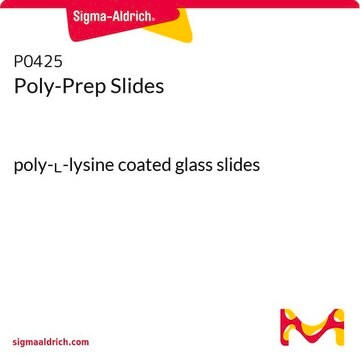P4832
Poly-ʟ-Lysine Hydrobromide
synthetic, mol wt 150,000-300,000, solution, 0.01%, suitable for cell culture
Sinónimos:
PDL Solution
About This Item
Productos recomendados
product name
Poli-L-lisina solution, mol wt 150,000-300,000, 0.01%, sterile-filtered, BioReagent, suitable for cell culture
sterility
sterile-filtered
product line
BioReagent
form
solution
mol wt
150,000-300,000
packaging
pkg of 50 mL
concentration
0.01%
technique(s)
cell culture | mammalian: suitable
impurities
endotoxin, tested
solubility
water: soluble
shipped in
ambient
storage temp.
2-8°C
InChI
1S/C18H38N6O4/c19-10-4-1-7-13(22)16(25)23-14(8-2-5-11-20)17(26)24-15(18(27)28)9-3-6-12-21/h13-15H,1-12,19-22H2,(H,23,25)(H,24,26)(H,27,28)/t13-,14-,15-/m0/s1
InChI key
WBSCNDJQPKSPII-KKUMJFAQSA-N
¿Está buscando productos similares? Visita Guía de comparación de productos
Categorías relacionadas
General description
Application
- In coating 96-well plates for cell attachment in testing respiratory burst activity.
- In coating glass cover slips for immunofluorescent labeling of intracellular structures.
- For pretreating 6-well plate in myosatellite cell isolation protocol.
- In coating coverslips for cell adhesion in E14 neuron culture to study possible mechanism of action of circRNA_01477 in neurons.
Biochem/physiol Actions
Components
Preparation Note
comparable product
related product
Storage Class
12 - Non Combustible Liquids
wgk_germany
WGK 2
flash_point_f
Not applicable
flash_point_c
Not applicable
Certificados de análisis (COA)
Busque Certificados de análisis (COA) introduciendo el número de lote del producto. Los números de lote se encuentran en la etiqueta del producto después de las palabras «Lot» o «Batch»
¿Ya tiene este producto?
Encuentre la documentación para los productos que ha comprado recientemente en la Biblioteca de documentos.
Los clientes también vieron
Artículos
Poly-Lysine enhances cell binding with positively-charged surface ions, optimizing electrostatic interaction on culture surfaces for increased cell attachment.
3D cell culture overview. Learn about 2D vs 3D cell culture, advantages of 3D cell culture, and techniques available to develop 3D cell models
Cancer stem cell media, spheroid plates and cancer stem cell markers to culture and characterize CSC populations.
Protocolos
Adhere cells to solid substrates using poly-lysine, which enhances electrostatic interaction between negatively charged ions of the cell membrane and the culture surface.
Nuestro equipo de científicos tiene experiencia en todas las áreas de investigación: Ciencias de la vida, Ciencia de los materiales, Síntesis química, Cromatografía, Analítica y muchas otras.
Póngase en contacto con el Servicio técnico







